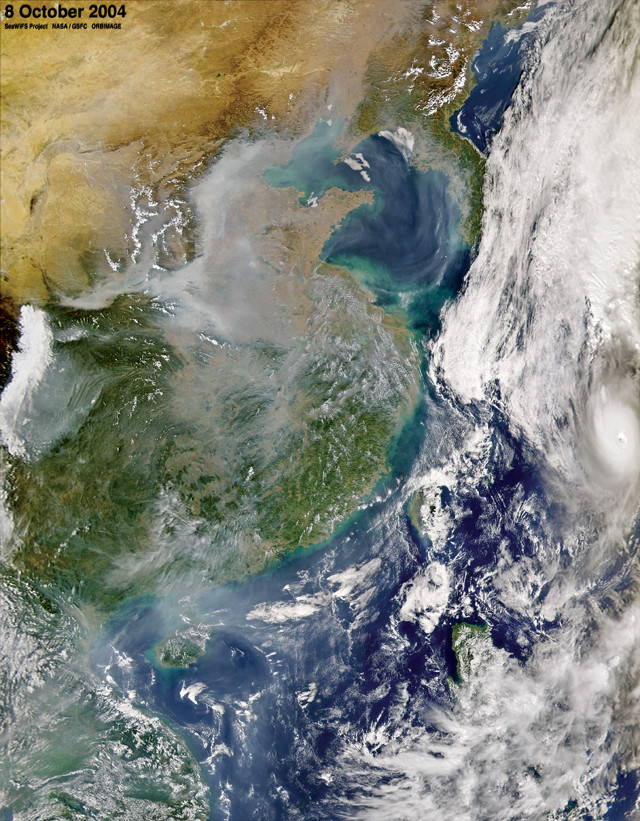
by Bethany Augliere Thursday, February 16, 2017

Thick haze hangs over eastern China in October 2004. Credit: NASA SeaWIFS Project.
In December 1952, a fatal fog crept through London for almost five days, smothering the city in a yellow haze that reeked of rotten eggs. The “Great Smog,” as it was called, caused up to 12,000 deaths and left more than 150,000 people hospitalized in the worst air pollution event in European history. The calamity sparked the British Parliament to pass the Clean Air Act in 1956, but the exact chemical processes that caused the event have remained a mystery, until now.
Haze results from an accumulation of fine particulate matter — liquid or solid particles with diameters smaller than 2.5 micrometers, which are often produced by coal burning and gasoline combustion, among other processes — in the air. Coal burning produces sulfur dioxide, which can be converted in the atmosphere to sulfate particulates in the form of sulfuric acid. That this conversion occurs is well known, says Renyi Zhang, an atmospheric chemist at Texas A&M University and co-author of a new study in Proceedings of the National Academy of Sciences. “Our objective was to find out the chemical processes leading to sulfate formation.”
By studying severe haze events in two Chinese cities, Beijing and Xi’an, using a combination of atmospheric and laboratory measurements, Zhang and his colleagues have shed light on pollution problems in both modern China and mid-20th-century London.
“Every winter, the air quality in nearly every major Chinese city reaches horrifying levels, where visibility is sometimes reduced to a few hundred meters,” says Russell Dickerson, an atmospheric scientist at the University of Maryland who was not involved in the study. At times, you might not recognize a friend across the street, he says. The World Health Organization recommends 25 micrograms per cubic meter as the maximum safe level of fine particulate matter; in China, it frequently rises above 100 micrograms per cubic meter and has soared to more than 500 micrograms per cubic meter at times. The smog in China’s cities is not as acidic, or as acutely toxic, as that which engulfed London; nonetheless, at such high levels it can have severe negative impacts on human health, particularly respiratory health. “It’s essential to understand the origin of those pollutants in order to have an effective solution to implement,” Dickerson says.
The typical pathway for the conversion of sulfur dioxide to sulfate in the atmosphere involves hydroxyl radicals, Zhang says. This reaction takes about 10 days under normal conditions, but haze in China often forms in just one or two days, so that reaction doesn’t explain the phenomenon. This led the team to think of other oxidants that could trigger the sulfur dioxide-to-sulfate conversion, including nitrogen dioxide, which also comes from coal burning and is in vehicle emissions as well.
Indeed, Zhang’s team found that nitrogen dioxide contributed to the rapid production of haze in the presence of high humidity: Sulfate formed when nitrogen dioxide and sulfur dioxide mixed with water droplets in the air. Normally, this reaction would cause the resulting haze to acidify, which would then inhibit the reaction from continuing. But a third factor is atmospheric ammonia, which China produces in large amounts through agriculture and insufficient sewage treatment: Ammonia neutralizes sulfuric acid, allowing the haze-producing reaction to continue while simultaneously mitigating the toxicity of the Chinese haze, relative to what happened in 1952 London at least.
The researchers found that sulfate haze at concentrations of more than 100 micrograms per cubic meter was formed when sulfur dioxide and ammonia concentrations were about 50 parts per billion, the nitrogen dioxide concentration was several hundred parts per billion and the relative humidity was greater than 70 percent. Those conditions were reproduced in the laboratory with the same results. “You can only form this severe haze under such conditions,” Zhang says.
“Not only does this study help us understand where the pollution comes from in industrialized China,” Dickerson notes, “but it might be predictive of air quality problems in other countries.”
It also explains what happened during the Great Smog. Particles in the London fog started out two orders of magnitude bigger than those in China, according to previous meteorological experiments. Initially, these large water droplets diluted the acid that formed. Over time, however, water evaporated from the haze but the acid did not, which created a concentrated acidic fog for multiple days. London did not have the same amount of ammonia in its skies that modern China does; without the ammonia to neutralize the haze, the Londoners were essentially breathing in highly acidic particles. It was likely the acidity that led to so many deaths in December 1952, Zhang and his colleagues wrote.
© 2008-2021. All rights reserved. Any copying, redistribution or retransmission of any of the contents of this service without the expressed written permission of the American Geosciences Institute is expressly prohibited. Click here for all copyright requests.